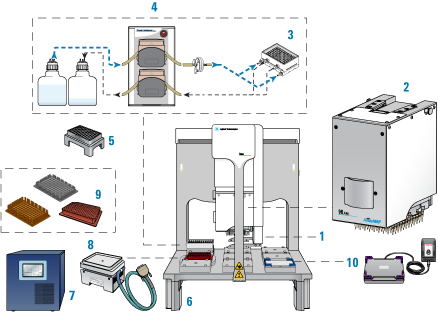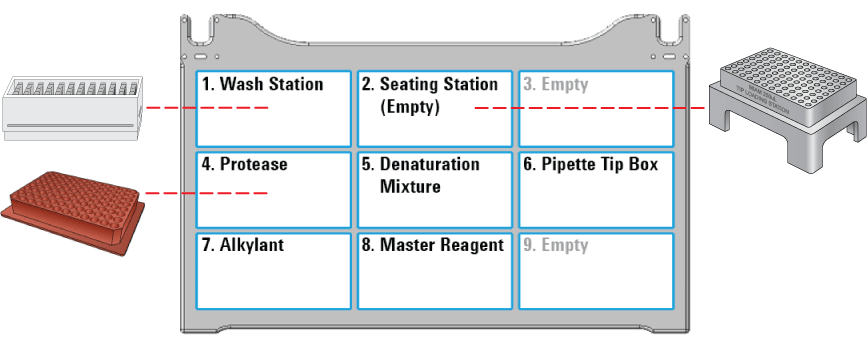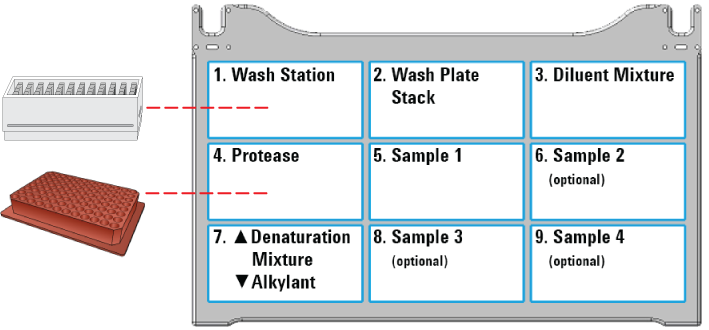Before you start

This topic lists the required hardware, software, AssayMAP Starter Kit, labware, and reagents for running the In-Solution Digestion: Multi-Plate protocol. If you have questions about these items, contact Agilent Customer Service.
Hardware
The following figure and table show the components of the AssayMAP Bravo Platform, which is required for running the AssayMAP protocols.
Figure AssayMAP Bravo Platform components
 |
Item | Required hardware |
|---|---|
1 | Gripper upgrade |
2 | Bravo 96AM Head |
3 | 96AM Wash Station |
4 | Pump Module 2.0 and two carboys |
5 | 96AM Cartridge & Tip Seating Station |
6 | Risers, 146 mm |
7 | Peltier Thermal Station with STC controller |
8 | Custom plate nest |
9 | Thermal plate insert for efficient heat transfer on the Peltier Thermal Station |
10 | Orbital Shaking Station with Control Unit |
Optional equipment. The following equipment is recommended when preparing the samples and reagents:
• Microplate centrifuge, such as the Agilent Microplate Centrifuge or equivalent
• Microplate sealer, such as the Agilent PlateLoc Thermal Microplate Sealer or equivalent
Software
The following table lists the minimum software requirements.
Software | Version |
|---|---|
Agilent VWorks Plus (compliance-enabled edition) or VWorks Standard | 14.4 |
Agilent Protein Sample Prep Workbench | 4.0.2 |
Microsoft Excel Required for the reagent volume calculators and method setup tools. | Microsoft Office 365 32-bit edition |
For an overview of the software components, see Overview of software architecture.
Labware and starter kits
The In-Solution Digestion protocol works with a broad range of user-supplied reagents for denaturation, reduction, alkylation, and proteolysis steps. This protocol requires a specific set of labware that can be sourced from various vendors.
Labware
The following table provides a complete list of labware options and the corresponding deck locations.
The following figures show the nine Bravo deck locations for labware.
Figure Reagent Plate Setup labware locations on the Bravo deck (top view)
 |
Figure In-Solution Digestion labware locations on the Bravo deck (top view)
 |
Labware | Manufacturer part number* | Deck location options |
|---|---|---|
Reagent Plate Setup labware | ||
• 96 Red PCR Insert + 96 Eppendorf 30129300, PCR, Full Skirt | Agilent insert (provided) and Eppendorf 30129300 | 4 |
• 96 Greiner 650207_U-Bottom, White PolyPro | Greiner 650207 | 5, 7 |
• 250-µL pipette tips | Agilent 19477-002 | 6 |
• 96 ABgene 1127, Deep Well, Square Well, Round Bottom | ABgene AB-1127 | 8 |
In-Solution Digestion labware | ||
• 96 Greiner 650207_U-Bottom, White PolyPro | Greiner 650207 | 2, 5– 9 |
• 96 ABgene 1127, Deep Well, Square Well, Round Bottom | ABgene AB-1127 | 3 |
• 96 Red PCR Insert + 96 Eppendorf 30129300, PCR, Full Skirt | Agilent insert (provided) and Eppendorf 30129300 | 4 |
*For dimensionally equivalent alternatives and other details about the labware, see the Labware Reference Guide in the Literature Library page of the Protein Sample Prep Workbench. | ||
Starter kits
Agilent offers starter kits for performing In-Solution Digestion and Peptide Cleanup, as these two applications are often performed sequentially. The following table lists the two starter kits that are available for In-Solution Digestion and Peptide Cleanup. Each starter kit contains both cartridges and labware.
Kit | Part number |
|---|---|
AssayMAP Digestion and RP-S Cleanup Starter Kit— Contains 96 reversed-phase (RP-S) cartridges and starter kit labware for In-Solution Digestion and Peptide Cleanup. | G5496-60034 |
AssayMAP Digestion and C18 Cleanup Starter Kit— Contains 96 C18 cartridges and starter kit labware for In-Solution Digestion and Peptide Cleanup. | G5496-60013 |
For more information on the cartridges, see the AssayMAP cartridges in the Peptide Cleanup 4.0 User Guide.
Starter kit labware
The following table lists labware that are included in the starter kits (G5496-60034 and G5496-60013).
Note: Additional labware are included in the starter kits but are required for the Peptide Cleanup application only. For more information, see Peptide Cleanup v4.0 User Guide.
Labware | Part number |
|---|---|
1.2 mL Deep-Well PolyPro Clear Plates (qty 2) | ABgene AB-1127 |
96-Well U-Bottom PolyPro White Plates (qty 11) | Greiner 650207 |
96-Well PCR Plates (qty 3) | Eppendorf 30129300 |
12-Column Low-Profile Reservoirs (qty 4) | Agilent 201280-100 |
96-Well Round-Bottom, Clear Plates (qty 2) | Greiner 650201 |
250-µL Pipette Tips | Agilent 19477-002 |
For details about the labware, see the Labware Reference Guide in the Literature Library page of the Protein Sample Prep Workbench.
Reagents
The volume, type, and concentration of reagents required to prepare for the In-Solution Digestion: Multi-Plate protocol depends on a combination of factors, including specific chemistry requirements, the number of samples to process, and volumes and concentrations of reagents necessary to conduct denaturation, reduction, alkylation, and proteolysis. The In-Solution Digestion Reagent Volume Calculator manages this complexity by preparing a reaction summary, optimized solution recipes, and microplate layouts for all master reagents based on your input values.
Consult published literature for reagent recommendations for sample and surface chemistry combinations. See the Agilent AssayMAP Bravo Citation Index for published papers that use the AssayMAP In-Solution Digestion: Multi-Plate application.
By default, the syringes are rinsed thoroughly with deionized water at the wash station after completing the protocol to reduce the risk of premature syringe failure. To perform more stringent syringe washing between runs, use the Syringe Wash utility. For details, see Syringe Wash v3.0 User Guide.
All labware require volume overage for the protocol to execute properly. Use the Reagent Volume Calculator to determine volume requirements for specific protocol conditions. See Preparing the solutions.